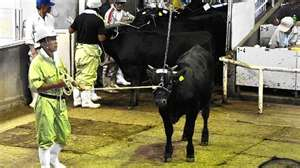 Radiation fallout from the wrecked Fukushima nuclear plant poses a growing threat to Japan’s food chain as unsafe levels of cesium found in beef on supermarket shelves were also detected in more vegetables and the ocean.
Radiation fallout from the wrecked Fukushima nuclear plant poses a growing threat to Japan’s food chain as unsafe levels of cesium found in beef on supermarket shelves were also detected in more vegetables and the ocean.
More than 2,600 cattle have been contaminated, Kyodo News reported July 23, after the Miyagi local government said 1,183 cattle at 58 farms were fed hay containing radioactive cesium before being shipped to meat markets.
Agriculture Minister Michihiko Kano has said officials didn’t foresee that farmers might ship contaminated hay to cattle ranchers. That highlights the government’s inability to think ahead and to act, said Mariko Sano, secretary general for Shufuren, a housewives organization in Tokyo.
“The government is so slow to move,” Sano said. “They’ve done little to ensure food safety.”
Aeon Co., Japan’s biggest supermarket chain, said today 4,108 kilograms (9,056 pounds) of beef suspected of being contaminated was inadvertantly put on sale at 174 stores across Japan. Supermarkets started testing beef after the Tokyo Metropolitan Government found radioactive cesium in slaughtered cattle this month.
The government on July 19 banned cattle shipments from Fukushima prefecture, though not before some had been slaughtered and shipped to supermarkets. A ban on shiitake mushrooms from another part of Fukushima was introduced on July 23 because of cesium levels, the health ministry said.
Seafood Concerns
“Some areas still have high radiation dosages and if you also eat products from these areas, you’ll get a considerable amount of radiation,” said Sentaro Takahashi, a professor of radiation control at Kyoto University in western Japan. “This is why the government needs to do something fast.”
Radiation in food is measured in becquerel, a gauge of the strength of radioactivity in materials such as Iodine-131 and Cesium-137.
As much as 2,300 becquerels of cesium a kilogram was detected in the contaminated beef, according to a July 18 statement from the health ministry. The government limit is 500 becquerels per kilogram.
Seafood is another concern after cesium-134 in seawater near the Fukushima plant climbed to levels 30 times the allowed safety standards last week, according to tests performed by Tokyo Electric Power Co, national broadcaster NHK reported.
Voluntary Testing
“We need to monitor the cesium 134 level detected in seawater around the plant,” Tetsuo Ito, the head of the Atomic Energy Research Institute at Kinki University in central Japan, said by phone today. “The increase could be from seawater churned by swells from the recent typhoon, but it’s possible that contaminated groundwater leaked from the plant.”
Japan has no centralized system to check for radiation contamination of food, leaving local authorities and farmers conducting voluntary tests. Products including spinach, mushrooms, bamboo shoots, tea, milk, plums and fish have been found contaminated with cesium and iodine as far as 360 kilometers from Dai-Ichi.
Hay contaminated with as much as 690,000 becquerels a kilogram, compared with a government safety standard of 300 becquerels, has been fed to cattle. Cattle with unsafe levels of the radioactive element were detected in four prefectures, the health ministry said July 23.
Radioactive Decay
A becquerel represents one radioactive decay per second, which involves the release of atomic energy that can damage human cells and DNA, with prolonged exposure causing leukemia and other forms of cancer, according to the World Nuclear Association.
Four months after the earthquake and tsunami damage to the Fukushima plant, local governments short of equipment, staff and funds are struggling to test all farm products.
The government is considering whether it’s feasible to test all cattle to prevent shipments of tainted meat to market, according to Yasuo Sasaki, senior press counselor for the agriculture ministry.
On June 6, Japan’s Nuclear and Industrial Safety Agency said the plant released about 770,000 tera becquerels of radioactive material into the air between March 11 and March 16, doubling an earlier estimate.
That’s about 14 percent of the radiation emitted in the Chernobyl disaster in modern-day Ukraine. About 2 million people in Ukraine are under permanent medical monitoring, 25 years after the accident, according to the nation’s embassy in Tokyo.
While 203 people were hospitalized and 31 died after the explosion at Chernobyl, about 400,000 children are considered to have received significant doses of radiation to their thyroid that merit monitoring, the embassy said.
Cases of thyroid cancer in Belarus, which neighbors Ukraine, increased for at least 10 years after 1986 in children younger than 14 and for almost 20 years among 20-24 year olds, according to research by Shunichi Yamashita of Nagasaki University, who was appointed as an adviser to Fukushima prefecture on radiation exposure.
To contact the reporter on this story: Aya Takada in Tokyo at atakada2@bloomberg.net
To contact the editor responsible for this story: Peter Langan at plangan@bloomberg.net